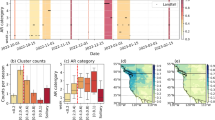Summary
¶During recent years, numerous studies have examined the Buenos Aires urban climate, but the relationship between large-scale weather conditions and the Buenos Aires urban heat island (UHI) intensity has not been studied. The goal of this paper is to apply an objective synoptic climatological method to identify homogeneous air masses or weather types affecting Buenos Aires during winter, and to relate the results to the UHI intensity. A K-means clustering method was used to define six different air masses considering the 03:00, 09:00, 15:00 and 21:00 LT surface observations of dry bulb temperature, dew point, cloud cover, atmospheric pressure and wind direction and velocity at Ezeiza, the most rural meteorological station of the Buenos Aires metropolitan area (Fig. 1). Results show that the mean UHI intensity is at its maximum (2.8 °C) a few hours before sunrise when conditions are dominated by cold air masses associated with cold-core anticyclones, weak winds and low cloud cover. Inverse heat islands are found during the afternoon for all air masses indicating that surface processes are not dominant at that time. The relatively infrequent and warmest air mass is the only one that presents a mean negative urban-rural temperature difference (−0.1 °C) during the afternoon with the smallest diurnal cycle of the UHI intensity probably due to the prevailing high humidity and cloudy sky conditions. The paper provides an insight into the Buenos Aires urban–rural temperature difference under a variety of winter weather types and results could be useful to improve local daily temperature forecasts for the metropolitan area of Buenos Aires on the basis of the routine forecasts of weather types.
Similar content being viewed by others
Author information
Authors and Affiliations
Additional information
Received October 24, 2001; revised June 12, 2002; accepted October 10, 2002
Rights and permissions
About this article
Cite this article
Bejarán, R., Camilloni, I. Objective method for classifying air masses: an application to the analysis of Buenos Aires’ (Argentina) urban heat island intensity. Theor. Appl. Climatol. 74, 93–103 (2003). https://doi.org/10.1007/s00704-002-0714-4
Issue Date:
DOI: https://doi.org/10.1007/s00704-002-0714-4




